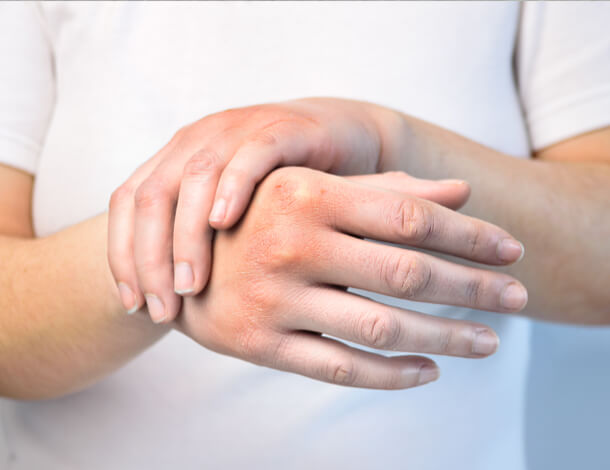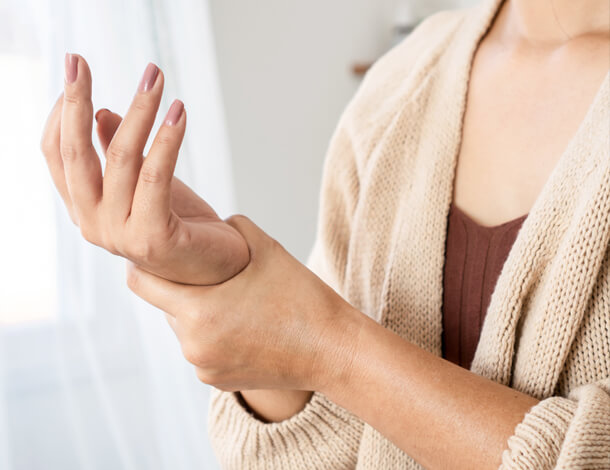Poor Hand Circulation: Is It Normal or Something More Serious?

It can be scary when your fingers get abnormally cold, change colors, or go numb. If you notice this sort of thing happens regularly and it’s interfering with your day-to-day life, you might start to wonder if it’s a sign of poor hand circulation.
Sure, everyone’s hands hurt sometimes. But when your fingertips regularly turn blue or white or feel like ice cubes even indoors, it’s worth a closer look. “Two frequent signs of poor hand circulation are color changes and cold intolerance,” says Dr. Ian Chow, a hand pain specialist at Indiana Hand to Shoulder Center. “In severe cases, disrupted blood flow to the hands can result in tissue loss.”
It’s not always easy to tell if your cold fingers issue is temporary or if you’re dealing with a real blood flow problem. This is why catching these warning signs early matters. Poor hand circulation usually has an underlying cause, some of which respond well to simple lifestyle changes, while others may require expert care.
Read on to find out which conditions are linked to decreased blood flow to your fingers, how specialists diagnose this painful hand problem, and what some of its most common treatments are.
What Causes Poor Hand Circulation?
“When you’re talking about lack of blood flow to the fingers, there are a few different potential sources,” says Dr. Brandon S. Smetana, a hand pain specialist at Indiana Hand to Shoulder Center. “One is occlusion, where the vessels narrow or become blocked. The other is embolic, where a clot starts somewhere else in the body and then travels down the bloodstream until it blocks off circulation to the hand. Then, the third is spasming, where blood vessels temporarily constrict.”
Your hands need steady blood flow to work properly. When that flow gets disrupted, you’ll notice it quickly in your daily activities.
Blocked Blood Vessels
Blood clots and narrowed arteries can create blockages that prevent blood from flowing through your blood vessels. While arterial injuries can occur, blockages are more commonly caused by conditions like diabetes, smoking-related vascular disease, or blood clots.
Spastic Blood Vessels
Stress, cold temperatures, and other triggers can cause vessels to squeeze too tightly, reducing blood flow to your hands. These spasms can also be caused by certain medications, like beta-blockers, or result from work that involves using jackhammers, chainsaws, and similar machinery.
Why Your Hands Are Particularly Vulnerable
Your fingers have tiny blood vessels, and their small size makes them much more sensitive when larger vessels elsewhere in your body are under stress or when your hands are exposed to cold temperatures. Even grabbing a glass of ice-cold water, taking something out of the freezer, or walking into a store that’s blasting its AC on a steamy summer day can trigger symptoms.
Conditions That Can Affect Hand Circulation
Here are some of the most common medical conditions that can disrupt blood flow to your hands and fingers:
- Raynaud’s Syndrome Disease
- Blood Clots, Atherosclerosis, and Vascular Blockages
- Autoimmune Conditions
- Thoracic Outlet Syndrome
- Occupational and Trauma-Related Issues
Raynaud’s Syndrome Disease
Raynaud’s is probably what most people think of when they hear about circulation issues affecting the hands. “The main signs of poor circulation are color changes, cold intolerance, and in severe cases, tissue loss,” says Dr. Chow.
For many people with severe Raynaud’s, pain becomes the biggest problem. “Patients can be miserable when they have very bad blood flow to their fingers, especially after they’ve had an occlusive episode where they experienced a complete loss of blood flow,” says Dr. Smetana. “That’s just extremely painful.”
Primary vs. Secondary Raynaud’s: What’s the Difference?
Primary Raynaud’s happens on its own and isn’t associated with an underlying disease. The disorder is set off by stress or cold and typically responds well to simple measures, such as avoiding triggers and maintaining warmth. Secondary Raynaud’s is different because it’s caused by other medical conditions, like an autoimmune disease. Due to this connection to larger health issues, it typically requires more comprehensive treatment.
Blood Clots, Atherosclerosis, and Vascular Blockages
Sometimes blood flow gets blocked by clots that form suddenly, requiring immediate medical attention if your hand becomes cold, numb, and pale. Other times, fatty deposits build up inside your arteries over time, narrowing them and reducing blood flow. While you usually hear about this happening in the heart or legs, it can affect the arteries in your hands and arms too, particularly if you smoke or have diabetes.
Autoimmune Conditions
Diseases like lupus, rheumatoid arthritis, and scleroderma can cause inflammation in your blood vessels, leading to circulation problems in your hands. These conditions often start showing up as secondary Raynaud’s disease, where the underlying autoimmune process affects blood flow as part of a broader set of symptoms throughout the body. For instance, scleroderma is a type of autoimmune condition that is known for causing severe circulation issues in the hands.
Thoracic Outlet Syndrome
This happens when nerves or blood vessels get compressed between your collarbone and first rib, causing your hand to feel cold, numb, or weak, especially when you raise your arm overhead.
Occupational and Trauma-Related Issues
Repetitive vibration from tools or direct injury to blood vessels can also cause circulation problems, which is why a specialist will always ask about any history of trauma to the area, whether that’s repetitive use, like manual laborers, versus acute trauma.
“The solution for these problems isn’t always surgery,” says Dr. Chow. “There are lifestyle modifications, different medications, and other options that patients may be better served with. Surgery would be a later option.”
Learn About Other Causes of Hand Numbness and Pain
Diagnosing the Cause of Poor Hand Circulation
“When someone comes in with circulation problems, the most important thing is getting the full picture,” says Dr. Chow. “I need to understand whether symptoms started suddenly or came on slowly, if there are any underlying autoimmune conditions, and whether there’s been any trauma or injury to the area.”
When you see a hand specialist, they’ll start by asking detailed questions about your symptoms, such as:
- When did you first notice the color changes or numbness?
- Did you notice your symptoms suddenly after exposure to cold or stress, or have they been gradually worsening over the past few months?
- Do you have any conditions like diabetes or autoimmune diseases? And, if so, are you taking any medications as treatment?
What you tell your doctor during this first visit will help them narrow down the most likely cause of the symptoms you’re experiencing.
Additional Testing
One way to determine the cause of symptoms, such as finger numbness, cold hands, and changes in skin color, is with an ultrasound right there in the office. “I’ll use an ultrasound or Doppler to listen to blood flow in the fingers from the two major blood vessels that go into a patient’s hand,” says Dr. Chow. “By examining the sound waves, I can tell whether blood is moving normally or not.”
If this office testing doesn’t provide clear answers, the next step might be a CT angiogram. “As a screening test, I’ll often order a CT angiogram,” says Dr. Chow. “This is where dye is injected through an IV to create a 3D picture of your blood vessels.” This test can reveal if blockages or other problems are affecting the blood supply to your hand.
Here is some good news: Minor issues with hand circulation can often be resolved with simple treatment approaches.
Lifestyle Changes and Underlying Condition Management
For some patients, avoiding triggers makes a big difference. This might mean wearing gloves in cold weather, managing stress, or quitting smoking if that’s contributing to the problem. If your job involves using vibrating tools, your specialist may recommend modifications to reduce your exposure.
When poor hand circulation problems are related to diabetes, autoimmune diseases, or other medical conditions, better management of those underlying issues can help improve blood flow to your hands.
Medications
Several drugs can help improve blood flow to your hands. Calcium channel blockers are commonly prescribed to patients diagnosed with Raynaud’s disease, while other medications might be recommended if an autoimmune condition is determined to be the cause of poor blood flow to the fingers.
Advanced Care Options and Surgery
Most of the time, surgical procedures are considered only when other treatments haven’t worked, or when there’s a specific blockage that needs to be addressed.
“If I had to estimate, probably over 90% of patients don’t need surgery for hand circulation problems,” says Dr. Chow. However, when conservative treatments are insufficient, more advanced options are available. Some patients get relief with sympathetic nerve blocks, botulinum toxin (Botox) injections, or digital sympathectomies.
Managing these conditions long-term can be tricky due to the unpredictable nature of disorders that cause circulation issues. “We generally take a reactive approach rather than a proactive one with these conditions,” says Dr. Smetana. “The underlying disease process tends to progress on its own timeline. That’s why it’s important for people with conditions like Raynaud’s to also work with a rheumatologist because they can sometimes alter the course of the disease with systemic treatments.”
In more severe cases, solutions include bypass surgery to reroute blood flow around blocked arteries or arterial reconstruction to repair damaged blood vessels.
FAQs About Poor Hand Circulation
Here are answers to a few questions patients often ask about problems related to blood flow to the hands.
Why Are My Hands Always Cold Even When It’s Warm?
If your hands feel cold even in warm environments, it could indicate a circulation problem in your hands or that you may have an underlying condition (such as Raynaud’s, thyroid issues, or anemia) that’s causing your hands to feel cold even when it’s hot outside. The American Academy of Orthopaedic Surgeons notes that if you have persistently cold hands, it’s a good idea to get them evaluated by a specialist, especially if the issue is worsening or you are also experiencing color changes and numbness.
Will the Blood Flow to My Fingers Improve if I Quit Smoking?
Yes, quitting smoking can significantly improve symptoms like cold hands because nicotine restricts blood vessels and reduces circulation to your fingertips. In fact, according to researchers at the American Society for Surgery of the Hand (ASSH), finger blood flow can start improving within just seven days after you stop smoking.
Why Are My Hands Colder at Night?
It’s totally normal for your hands to feel colder at night because your body temperature drops slightly during sleep. Plus, blood flow to your hands is controlled by muscles around the arteries that can constrict more when you’re at rest. This natural slowdown of blood circulation at night also makes your fingertips feel cooler.
Why Do My Hands Stay Cold After Coming Inside? Should I Be Worried if My Fingers Seem to Always Take a Long Time to Warm Up?
It’s normal for hands to take time warming up since they’re the farthest from your heart, but if they consistently take much longer than usual or turn a different color, see a doctor. The ASSH explains that poor blood flow to the hands can signal underlying conditions, especially if accompanied by color changes or if warming up becomes increasingly difficult.
Is Frostbite the Same as Poor Hand Circulation?
Not quite. Frostbite happens when your fingers are exposed to freezing temperatures and the cold actually damages the tissue. That said, poor hand circulation issues (like diabetes and peripheral vascular disease) can make you more vulnerable to experiencing a frostbite injury because reduced blood flow means less warmth reaches your fingertips, making that tissue more susceptible to damage from the cold.
Expert Care for Hand Circulation Problems
The board-certified hand specialists at Indiana Hand to Shoulder Center have extensive experience diagnosing and treating circulation issues affecting the hands and fingers. With our in-office diagnostic capabilities and comprehensive treatment approach, we create individualized care plans tailored to each patient’s specific needs.
“Many people assume they have circulation problems when something else might be causing their symptoms,” says Dr. Chow. “What’s important to know is that if you’re experiencing any issues with your hands, we have comprehensive care here at the hand center. We can help with whatever might be affecting your upper extremity.”
Unfortunately, many people experiencing poor hand circulation often wait longer than necessary to seek specialist care. “I wish more patients would come in sooner, before they are living with constant pain,” says Dr. Smetana. “Because we have so many ways to help.” And that’s exactly what we’re here for: To help you regain normal hand function and get back to your daily activities without the worry of cold, numb, or discolored fingers.
When you need expert evaluation and treatment of hand circulation problems, you can count on the specialists at IHTSC. Call (317) 743-3985 to schedule your consultation or request an appointment online.

You Might Also Like:
- How to Pinpoint the Cause of Ring Finger Pain
- Knowing the Symptoms of a Broken Finger and When to See a Doctor
- Feeling Hand Stiffness? One of These Conditions Could Be to Blame
Medically reviewed by Brandon Smetana, MD, FAAOS
Disclaimer: The materials on this website have been prepared for informational purposes only and do not constitute advice. You should not act or rely upon any medical information on this website without a physician’s advice. The information contained within this website is not intended to serve as a substitution for a thorough examination from a qualified healthcare provider. The display of this information is not intended to create a health care provider-patient relationship between the Indiana Hand to Shoulder Center and you.



